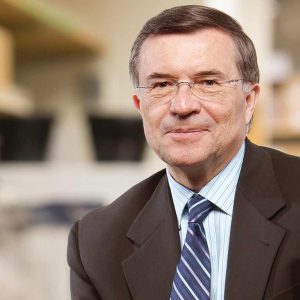
August 1, 2017
The National Science Foundation granted several million-dollar awards to multi-institute projects
The National Science Foundation granted several million-dollar awards to multi-institute projects
LA JOLLA—Two Salk neuroscience labs are part of a National Science Foundation (NSF) effort to better understand the brain. Salk Professors Terrence Sejnowski and Ed Callaway are each collaborators in multi-institute projects awarded over $9 million apiece.
The awards are granted through the BRAIN Initiative (through NSF’s Next Generation Networks for Neuroscience, NeuroNex) as part of a larger goal to establish a national infrastructure to enhance understanding of brain function across organizational levels and a diversity of species. Since its inception, the BRAIN initiative has focused on new technologies for uncovering brain function. The NeuroNex awards further that mission by providing scientific teams with the support that is required not only to continue to push boundaries, but to share their technologies with other brain scientists through hands-on workshops and courses.

Click here for a high-resolution image.
Credit: Salk Institute
Sejnowski, The University of Texas at Austin and the Texas Advanced Computing Center (TACC) have received a grant of over $9 million from the National Science Foundation (NSF) to unravel details of the brain, in particular by mapping connections called synapses. Led by UT Austin, the project will model synapse function and share the data publicly for use by scientists throughout the world.
“Our team at the Salk Institute will build a computational microscope to animate the electron microscope data from the NeuroNex project and probe the function of synapses at the molecular level,” says Sejnowski, laboratory head of Salk’s Computational Neurobiology Laboratory and a Howard Hughes Medical Institute investigator. The team will create a new electron microscope that can image larger volumes of brain matter while simultaneously peeking inside the tiniest substructure of individual synapses. The team will also build new computational modeling tools for understanding how synapse ultrastructure supports brain function.
Callaway and a group at Stanford University have also received over $9 million through the NeuroNex awards. The team will merge principles from genetics, physics, optics, engineering and biology to build and disseminate methodology, instrumentation and analytics that enable targeting and control of individual kinds of brain cells. The outcome will be a broadly applicable platform for discovering how neural circuit activity gives rise to complex cognitions and behaviors in the brain, which will lead to a better understanding of neurological and psychiatric diseases.

Click here for a high-resolution image.
Credit: Salk Institute
This “dream team” of investigators are leaders in each of the key genetic approaches being used to reverse-engineer the brain: Callaway for linking cell types to neural circuits, Liqun Luo for targeting gene expression to specific brain cell types, Mark Schnitzer for monitoring activity through imaging technologies, and principal investigator of the award Karl Deisseroth for the optogenetic manipulation of neuronal activity.
“We’re excited by the opportunity that this funding provides for us to work closely together in pushing our technologies to the next level and to share what we have learned with the community,” says Callaway, who holds the Audrey Geisel Chair in Biomedical Science.
This year’s 17 announced NeuroNex awards bring together researchers across disciplines with new technologies and approaches, yielding novel ways to tackle the mysteries of the brain. These projects will support the development of innovative, accessible and shared capabilities and resources, as well as theoretical frameworks and computational modeling to advance neuroscience research.
“Through the development of advanced instrumentation to observe and model the brain, we’re closer to our goal of building a more complete knowledge base about how neural activity produces behavior,” says Jim Olds, National Science Foundation assistant director for Biological Sciences. “NeuroNex seeks to take that progress forward, by creating an ecosystem of new tools, resources, and theories. Most importantly, NeuroNex aims to ensure their broad dissemination to the neuroscience community. With these awards, NSF is building a foundation for the next generation of research into the brain.”
Office of Communications
Tel: (858) 453-4100
press@salk.edu
Unlocking the secrets of life itself is the driving force behind the Salk Institute. Our team of world-class, award-winning scientists pushes the boundaries of knowledge in areas such as neuroscience, cancer research, aging, immunobiology, plant biology, computational biology and more. Founded by Jonas Salk, developer of the first safe and effective polio vaccine, the Institute is an independent, nonprofit research organization and architectural landmark: small by choice, intimate by nature, and fearless in the face of any challenge.